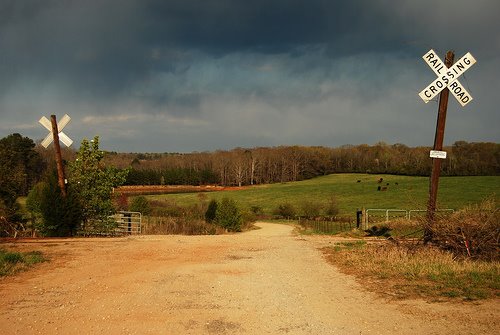Bostwick, GA
Population: 365
 side. Additional rooms, apparently used for an apartment for the hotel manager and his family, were also on the ground floor. Bathrooms were located at the rear on both the ground and upper floors. The rear of the second floor was devoted mainly to a Masonic Hall, which Bostwick, an active Mason, provided for the local lodge (the masonic lodge has since moved across the street).
side. Additional rooms, apparently used for an apartment for the hotel manager and his family, were also on the ground floor. Bathrooms were located at the rear on both the ground and upper floors. The rear of the second floor was devoted mainly to a Masonic Hall, which Bostwick, an active Mason, provided for the local lodge (the masonic lodge has since moved across the street).In the 1920s, when cotton was king, Bostwick thrived. The town had two cotton gins, a cotton seed oil mill, a depot and train station, a bank, a hotel, a dry cleaning business, three doctors, a blacksmith shop, post office, and three businesses with gas pumps. Two of the gas pumps, long out of order and slowly rusting away, still stand guard on Ruark Lane today.
Bostwick in 2009:
 The Bostwick Gin is one of the few operational cotton gins left in Georgia. Sitting idly by the side of GA 83 for most of the year, it is inspected and repaired every fall and fired up for the cotton harvest which typically starts around the time of the Annual Cotton Festival which takes place every year on the first Saturday of November, and features a road race, parade (including a most impressive accumulation of tractors), arts, crafts and food. The cotton mill is in operation during the festival and visitors are invited to file through the old gin to see how this all works. It is loud and dusty but well worth the trip. All proceeds from the festival go toward the continuing restoration of the Susie Agnes Hotel.
The Bostwick Gin is one of the few operational cotton gins left in Georgia. Sitting idly by the side of GA 83 for most of the year, it is inspected and repaired every fall and fired up for the cotton harvest which typically starts around the time of the Annual Cotton Festival which takes place every year on the first Saturday of November, and features a road race, parade (including a most impressive accumulation of tractors), arts, crafts and food. The cotton mill is in operation during the festival and visitors are invited to file through the old gin to see how this all works. It is loud and dusty but well worth the trip. All proceeds from the festival go toward the continuing restoration of the Susie Agnes Hotel.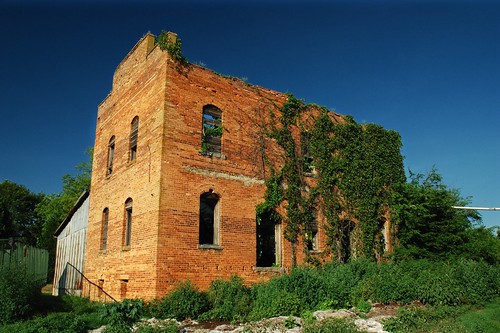 This abandoned structure adjacent to the cotton gin was once used to store fertilizer. The railroad spur ran to the right of the building (between the building and the gin). The building is often mistaken for a cotton warehouse, but Bostwick never had one.
This abandoned structure adjacent to the cotton gin was once used to store fertilizer. The railroad spur ran to the right of the building (between the building and the gin). The building is often mistaken for a cotton warehouse, but Bostwick never had one. The Susie Agnes Hotel, added to the National Register of Historic Places in 1994, is an example of a turn-of-the-century commercial and hotel building typically found Georgia's smalltowns. The building was designed by W.D. Calvin, a local Morgan County architect and builder who also designed several other buildings in Bostwick. The building was originally used as both hotel and commercial space as well as a meeting space for the local Masonic Lodge. It serves as the City Hall today.
The Susie Agnes Hotel, added to the National Register of Historic Places in 1994, is an example of a turn-of-the-century commercial and hotel building typically found Georgia's smalltowns. The building was designed by W.D. Calvin, a local Morgan County architect and builder who also designed several other buildings in Bostwick. The building was originally used as both hotel and commercial space as well as a meeting space for the local Masonic Lodge. It serves as the City Hall today. The Bostwick Supply Company, the area country store that once also housed the local post office and bank, had remained in operation as a general store and later, video rental, until March 2009. You could stop by to pick up a few nails, buy some hoop cheese, marvel at the collection of old stuff and remnants of the bank inside the store, pet Ringo the dog, and then grab a hot dog and a coke and hang out on the porch to watch the world go by. If you'd hang out long enough you could catch one of the Ruarks stopping by, and you could talk cotton; but eventually, the bad economic times and a crumbling building forced the store to close its doors for now. Today, it stands abandoned, but no less proud.
The Bostwick Supply Company, the area country store that once also housed the local post office and bank, had remained in operation as a general store and later, video rental, until March 2009. You could stop by to pick up a few nails, buy some hoop cheese, marvel at the collection of old stuff and remnants of the bank inside the store, pet Ringo the dog, and then grab a hot dog and a coke and hang out on the porch to watch the world go by. If you'd hang out long enough you could catch one of the Ruarks stopping by, and you could talk cotton; but eventually, the bad economic times and a crumbling building forced the store to close its doors for now. Today, it stands abandoned, but no less proud. 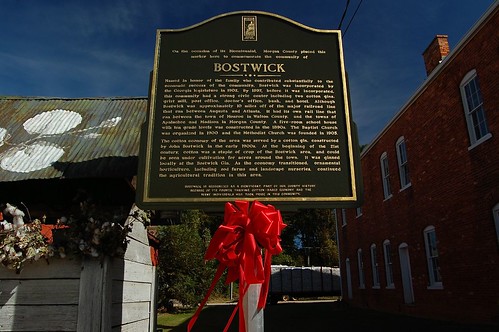
In October 2010, Hollywood descended upon Bostwick for a second time (first time was for the 1992 movie "My Cousin Vinny") to film the remake of "Footloose" featuring Kenny Wormald as Ren and Julianne Hough as Ariel (it also features at least one local that I know of: one of the workers feeding cotton into the gin called out "hey, Ren!" and they liked it enough to cut him a check and make it official). The cotton gin kept on ginning for most part, and in the end was able to keep a wooden platform that was built at the entrance to the cotton seed building, where the dance scene was filmed.

 While some buildings continue to decay (the roof of the Bostwick Store has now collapsed), and the old cotton seed truck has taken a hit, cotton is still alive here, the Cotton Gin Festival is as popular as ever, and photographers continue to visit this gem of an American smalltown. Some changes took place in the fields behind the gin: the cow pasture was turned into a field with rotating crops, trees were cut down and a huge irrigation system was installed. I get much joy out of watching these fields change through the seasons, switching between wheat, soy and corn, and, in April 2013, a spectacular canola field.
While some buildings continue to decay (the roof of the Bostwick Store has now collapsed), and the old cotton seed truck has taken a hit, cotton is still alive here, the Cotton Gin Festival is as popular as ever, and photographers continue to visit this gem of an American smalltown. Some changes took place in the fields behind the gin: the cow pasture was turned into a field with rotating crops, trees were cut down and a huge irrigation system was installed. I get much joy out of watching these fields change through the seasons, switching between wheat, soy and corn, and, in April 2013, a spectacular canola field.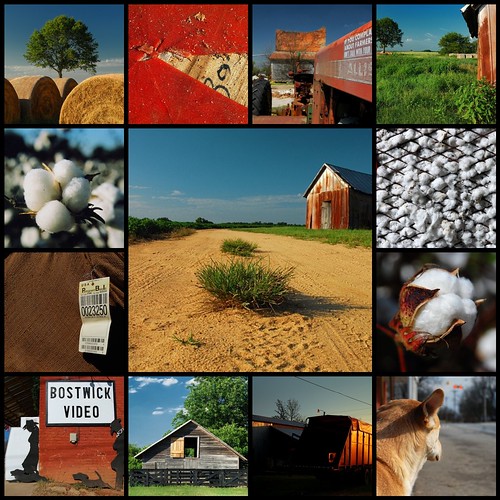

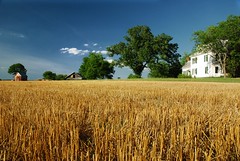





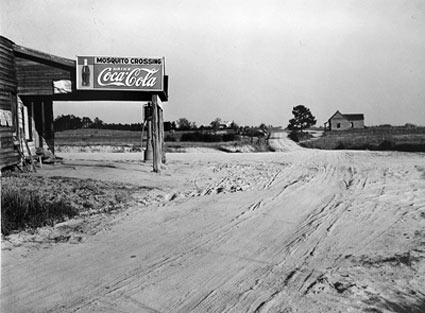
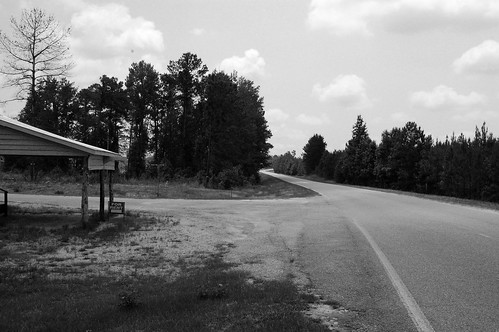 Mosquito Crossing, GA [Greene County]
Mosquito Crossing, GA [Greene County]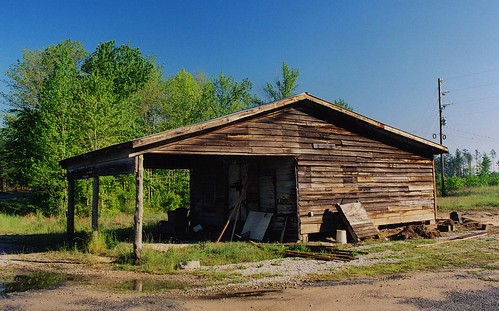 Mosquito Crossing, GA [Greene County]
Mosquito Crossing, GA [Greene County]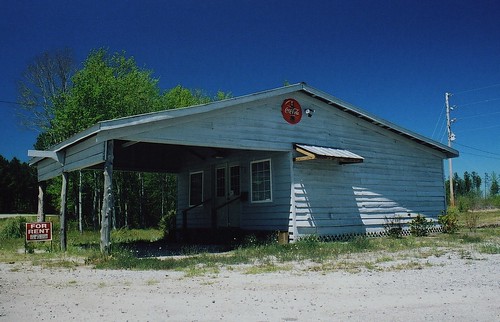 Mosquito Crossing, GA [Greene County]
Mosquito Crossing, GA [Greene County]


